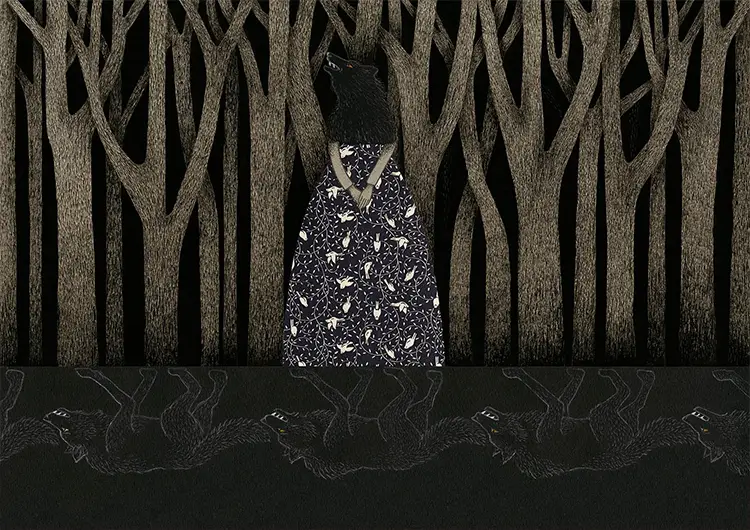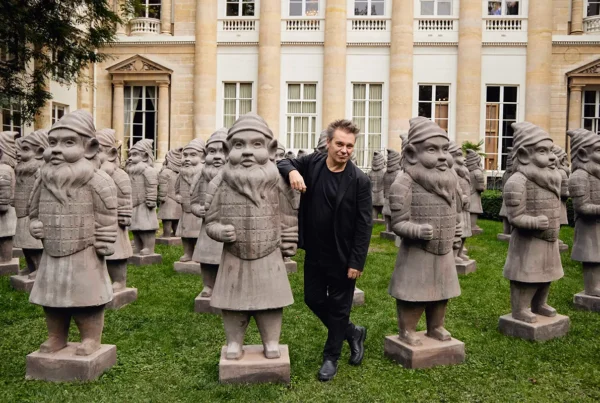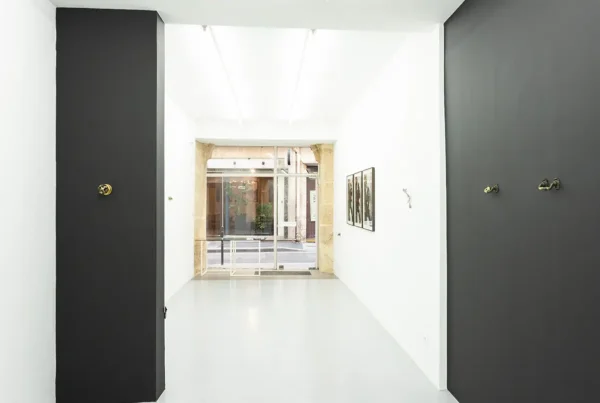“The profession of an artist is very close to that of an explorer.”
Through the Garden Gate: From Nature’s Wonder to Graphic Expression
The artistic journey of Viive Noor began not within gallery walls, but among trees, birdsong, and the quiet mysteries of marshlands surrounding her childhood home in Tallinn, Estonia. Born in 1955, Noor spent her formative years in a suburban house where the rhythms of nature fed her early imagination. Her initial dreams were not of brushes and ink but of exploration, with aspirations of a life connected to animals and the wild. Yet, the pull of creativity gradually overpowered these instincts. Drawing and painting soon became her dominant pursuits, leading her to enroll at the Estonian Academy of Arts. There, she pursued fashion design and graphic arts, ultimately graduating cum laude in 1981 with two master’s theses—one in fashion and another in children’s book illustration—reflecting the dual paths that would shape her professional life.
Since then, Noor has embraced her identity not merely as an artist, but as someone for whom art is inseparable from existence. Her commitment to creative exploration has manifested across multiple disciplines: children’s book illustration, printmaking, and the curation of international illustration exhibitions. Each of these areas not only reflects different facets of her skillset but also satisfies distinct emotional and intellectual needs. While her early career was deeply immersed in illustrating books for children—a form she still deeply values—recent years have seen a growing emphasis on her own graphic works. Despite the gradual shift, Noor insists that each creative pursuit remains vital to her sense of artistic wholeness. None can be discarded, for together they compose the full expression of her vision.
Participation in the global art scene has been a defining feature of Noor’s practice. Since 1978, she has contributed to more than 400 international exhibitions across over 30 countries, from Japan and Iran to the United States and France. With more than 90 solo exhibitions to her name, her presence has been especially strong in Estonia, but has extended through Northern and Eastern Europe. These extensive engagements have not only broadened her artistic exposure but also affirmed her status as a central figure in contemporary illustration. Her work regularly features in events like the Biennale of Illustrations Bratislava and the Golden Pen of Belgrade, and thematic exhibitions such as “It’s Always Tea-Time” and “Running with the Wolves,” each testament to her unique visual storytelling.
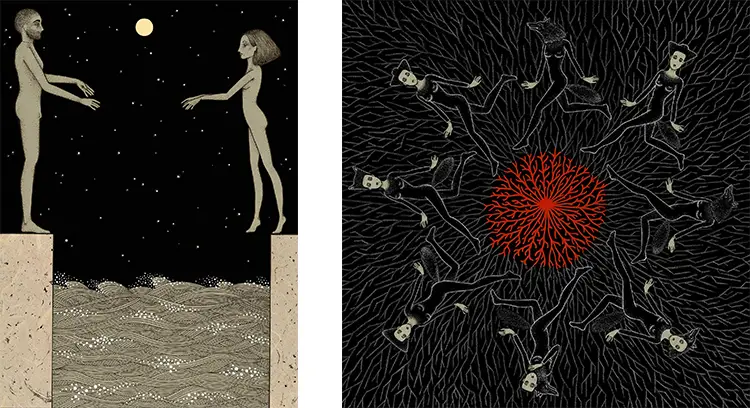
Viive Noor: A Life That Paints Itself
To describe Viive Noor’s work solely in terms of medium or style would be to miss its emotional and philosophical undercurrents. She resists categorization, acknowledging that critics have variously labeled her work as magical realism, symbolism, and, occasionally, surrealism—a label she quietly disputes. Instead of aligning with a singular movement or technique, she embraces the idea that her art is an organic extension of her inner life. Her creations emerge from personal introspection and universal emotion: love, loss, delight, dread. Noor’s perspective is that these experiences are shared by all, and thus every human viewer finds echoes of their own story in her images. This universality, filtered through her singular sensibility, creates artworks that resonate widely yet remain unmistakably hers.
Though she traverses multiple creative roles, from illustrator to curator, Noor believes these are not separate identities but expressions of a cohesive artistic soul. Her visual language has evolved with her personal and emotional shifts over time, just as her favored techniques have changed. In earlier stages, she produced pen drawings and lithographs, while watercolor dominated her children’s book illustrations. Today, she leans heavily into mixed media—pen, collage, touches of gouache—always created by hand. The process of making is for her a tactile, intuitive dialogue between artist and surface, and she steers clear of digital methods, preferring the immediacy and intimacy of manual creation.
Emotion is not only present in her themes, but also in her palette. A recurring comment from critics and viewers alike is the singular quality of her use of black. Far from symbolizing grief or darkness, Noor’s black carries a counterintuitive luminosity—it expresses life, joy, even celebration. This inversion of expectations is emblematic of her approach as a whole: she does not depict life as it appears, but as it is deeply felt. Perhaps it is this particular treatment of color, this transformative emotional honesty, that makes her work feel simultaneously grounded and otherworldly. It invites viewers to experience familiar truths from a renewed perspective, bathed in a light they did not expect.
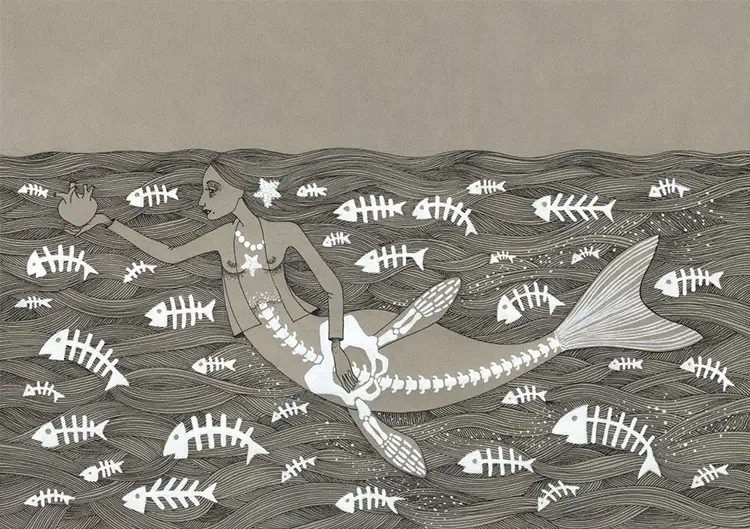
Echoes Between Love and Mortality
Central to Viive Noor’s artistic ethos are two profound and inescapable forces: love and death. She regards these not as binary opposites, but as intertwined conditions of existence, each shaping the human journey in fundamental ways. Her work often navigates this intersection, portraying the emotional textures of living with an awareness of both connection and impermanence. In this view, illustration is not merely visual decoration but a vehicle for conveying truths that words struggle to articulate. She sees each picture as a mirror—not just of the artist’s intentions but of the viewer’s psyche. Meaning in her work is never fixed; it is fluid, shaped by whoever engages with it and whatever emotions they carry.
This emphasis on interpretation is also why she refrains from identifying a single “masterpiece” in her career. While some artworks hold deep personal significance for her, the reasons are often private, not intended for public dissection. Yet, this reticence is not evasiveness—it is respect for the shared space between artist and audience. For Noor, the real strength of an artwork lies in its openness, its ability to hold multiple meanings simultaneously. Each viewer contributes to the life of the piece, bringing their experiences and emotions to bear. The result is an evolving dialogue that continues long after the work leaves her studio.
In terms of inspiration, Noor draws from a wide and eclectic range. She resists the idea of artistic idols, suggesting instead that everything she sees—every artwork, every culture, every journey—leaves a trace. Particularly strong is her affection for the folk traditions of diverse nations, which captivate her with their authenticity and rhythm. Though she does not directly quote these styles, they seep into her consciousness, enriching her sensibility with new textures and ideas. Her love of travel is tied to this curiosity, not as a means of escape, but as a source of subtle enrichment. These experiences inform not only her aesthetics but her worldview, cultivating a deep empathy that pulses through her creations.

Viive Noor: The Quiet Architecture of Creation
In her creative environment, Viive Noor values simplicity and presence. She does not require elaborate setups or stimulants to begin working. What she seeks is time—uninterrupted days in which she can immerse herself fully. Her process demands a mental shift, a descent into focus that cannot be rushed or slotted into spare hours. Once inside that space, however, her studio becomes a sanctuary, filled with the quiet breath of birdsong through an open window. At times, classical music or intellectually rich radio programs accompany her work, but these are carefully chosen moments. In many cases, silence offers the clearest dialogue between mind and material.
While the disciplines of illustration, printmaking, and curating might seem disparate, Noor perceives them as harmonizing parts of her creative being. Each serves a different purpose and offers a unique kind of satisfaction. Illustration connects her with narrative and audience, particularly children. Graphic art provides an avenue for introspection and philosophical exploration. Curation allows her to champion the work of others and contribute to the broader cultural landscape. The interplay among these disciplines keeps her inspired, ensuring that no single mode becomes stale or mechanical. She resists any push toward narrowing her practice, insisting that every element plays an indispensable role in her continued growth.
Despite her many accolades, including the prestigious Order of the White Star, Fifth Class, awarded by the President of Estonia in 2020, Noor remains focused on creation rather than recognition. Her work as Vice President of the Estonian Section of IBBY, her leadership within the Estonian Graphic Designers’ Association, and her curatorial efforts at the Estonian Children’s Literature Centre all exemplify her dedication not only to her own craft but to the cultivation of visual storytelling as a cultural force. Even without a formal website, her visibility continues through exhibitions and collaborations, anchoring her influence in the evolving landscape of international illustration. For Noor, art is not a goal but a process—one she follows with quiet intensity, day after day.
